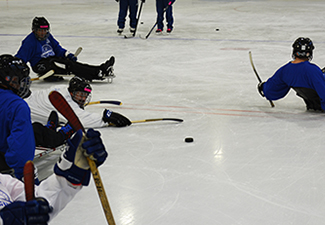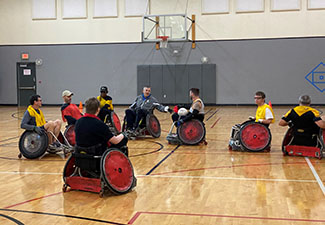Living With The Good Pain, On Her Terms
Woman warrior Carla Best lives life with chronic pain after a traumatic combat injury while deployed with the Army in Iraq.

Warrior Carla Best uses her crutches to take her wheelchair from the back of her vehicle.
It’s morning, a time when most Americans are rested, rejuvenated, and ready to take on the day. For warrior Carla Best, stiff shoulders due to arthritis and a restless night mean it’s time for a series of stretching exercises before she can even get out of bed.
“Once I’m awake and once I’m up, the first thing I have to do is use my crutches,” said Carla, “but not trying to use them too correctly because you’re trying not to put all your weight on your shoulders.”
A persistent pain in Carla’s shoulders is something the Army veteran lives with, and she’s not alone. In fact, according to the most recent Wounded Warrior Project® (WWP) Warrior Survey*, 76% of warriors said pain moderately or severely interfered with their ability to enjoy life. But for Carla and many others, it’s not the only injury they live with, and it’s far from their original injury.
A Call to Serve
Carla grew up in a military family. Her father served in the Navy, her grandfather served in the Army during the Korean War, and her younger brother served in the Army with a deployment to Iraq. That’s exactly where Carla, a U.S. Army sergeant, found herself on Oct. 9, 2004.
After four years in the Army, a mission in Iraq starting at 8 p.m. to gather several vehicles and bring them back to base was the first mission outside of the Green Zone for Carla, an Army mechanic. Carla recalls that white flares started going off about 100 feet from her vehicle the instant her convoy left the Green Zone; the flares were not set off by the Army. Ten minutes later, Carla had an uneasy feeling when another white flare fired into the sky. Then she saw a green flare, and her life changed forever.

Carla served in the U.S. Army from 2000 – 2006
“As soon as that green flare popped off, there was an explosion,” Carla said. “It sucked all the air out of the vehicle, and it was just a bright light, and then just dirt instantly everywhere. I could not see anymore, and it was just cloudy and smoky. All you could hear was screaming.”
Carla and another soldier in her vehicle were taken by helicopter to a military hospital in Baghdad, shrapnel and shards of metal protruding from her legs. She remembered screaming back and forth with her fellow soldier, telling each other they’d be OK. At the hospital, she reunited with her brother, who stayed with her for six hours as the siblings cried together. As the clock ticked past midnight, it was her brother’s birthday.
Welcome to Ward 57
When Carla was stable enough to fly, the Army sent her to Walter Reed Army Medical Center, where she spent two years with other injured service members. Initially, doctors tried to save her legs, so she had knee fusion surgery with an external fixator attached to her left leg.
“Pain management at that point was a lot of drip medications from the hospital,” Carla recalled. “I was on fentanyl, fentanyl patches, suckers that had fentanyl in them; they were just throwing a bunch of medications at whatever they could because the pain was so intense.”
The soldier who was injured in the same explosion in 2004 had his leg amputated and began learning how to walk with a prosthetic. After 18 surgeries, with the hopes of being able to become active again, Carla asked for her left leg to be amputated above the knee.
“I have really bad phantom pain from that,” she said. “I have bad muscle spasms, even when I’m not doing anything, my leg will just start jumping because of the muscle spasms. I have problems sleeping because of the phantom pains.”
Carla’s left leg was amputated in 2006. The blast in 2004 also destroyed 40% of the muscles in her right leg.

Carla deployed to Iraq in 2004
Life According to Opioids
Carla left the Army after her left leg was amputated in 2006, but that’s when her pain began to take multiple forms. Physically, her legs hurt every day, and treating that pain created a new type of pain: addiction.
“I would literally take my pills and that was the only thing I thought of and focused on,” Carla said as she recalled a life of consuming pills at all hours of the day.
“My biggest fear is that I would run out of pills, and I would run out of pills all the time because I’m dropping pills, I’m taking pills when I’m not supposed to be taking pills. My whole life revolved around pills.”
“I wouldn’t go anywhere because I would be a drooling mess; I was the epitome of what I would consider a drug addict,” said Carla. “You can’t do any activities; you can’t live a normal life because literally all you’re thinking about is your pills. You can’t drive anywhere because you’re completely high, and it takes away all of your independence, all of your desire to do anything in the world. It’s all about the pills.”
A life on opioid painkillers was not the life Carla wanted to live. Her legs still hurt, she was gaining weight because she was inactive, and she shut herself off from society. After nearly 15 years on opioids, she decided to make a change and try a different method to manage her pain.
A Healthy Type of Pain
In December 2023, Carla signed up for a Wounded Warrior Project sled hockey clinic. She never watched hockey, knew nothing about hockey, but found a welcoming community of people with similar injuries and military experiences.
“That first step back into movement and activity is so important,” said Randa Osman, a WWP adaptive sports specialist, who organized the 2023 sled hockey clinic. “The hardest part is taking the first step out the door. Once you get fresh air, movement in the muscles, and get the blood flowing, it all falls into place. Carla opened up and brought so much fun to the group, and has become a lot more independent since that first sled hockey event.”
WWP hosts dozens of adaptive sports events every year throughout the country.
“It snapped me out of my funk because I was in a very bad place mentally, so that was definitely a lifesaver,” Carla said. “I can’t always do sled hockey, it’s very physically demanding, so I started doing other adaptive sports like pickleball and anything I can do that’s safe. I love team sports right now, so I’m having a lot of fun getting out there.”
“That’s our goal with exposing warriors to adaptive sports,” said Randa. “Adaptive sports help them feel confident and learn to participate independently in events. It was really cool to see Carla break through her isolation and sedentary lifestyle.”
Carla is now very involved in the Colorado Sled Hockey Association and wants to create opportunities to play for other veterans and even children who would benefit from the sport.
“Sled hockey lit a fire and that fire has stayed lit from the start,” Randa said. “After chatting with Carla after other events, she really homed in on her diet and her mental health, and all of this is a domino effect from taking that first step to become active and engaged.”
She plays when she can, and is oftentimes very sore from playing, but Carla avoids taking opioids.

Carla started playing sled hockey after a WWP adaptive sports program in 2023
“I’ve been getting cortisone injections in my shoulders, but there’s a lot of pain that the medications don’t do anything for, so alternate therapies are my best bet,” she said. “I do a lot of acupuncture and massage therapy, anything I can do outside of taking pills, I’m all for it.”
Much of her shoulder pain is caused by using crutches because she lost her leg after the 2004 explosion in Iraq, a pain that has evolved over two decades.
“I really don’t wear my prosthetic leg the way that I would like to because of the pain that it causes, so it’s a matter of having choices and knowing what my limit is for the day,” Carla said. “What can I do to maximize what I need to do and not overexert myself because of the pain, and then be a wreck for the rest of the day?”
Carla said that sled hockey is strenuous, especially on shoulders that are already in pain. But the thrill of competing, the joy of being around teammates, and the sense of accomplishment she feels by getting out on the ice and being active make this new type of pain productive.
“It’s a good pain because it’s the pain you’re getting from the satisfaction of playing,” said Carla. “Normally, pain is a very isolating thing; you’re in your house, hiding in your room. Your family knows about your pain, but your friends and colleagues don’t. So being around people who are amputees, in wheelchairs, or have mental limitations, we’re all playing the same sport and we’re getting on the ice and playing, so it makes it worth it.”
WWP programs and services help warriors achieve better health and thrive for a lifetime. These programs provide essential lifelines to families and caregivers. WWP inspires the hope and purpose that help prevent veteran suicide. We leave no warrior behind.
*Warrior Survey, Wave 3 (conducted June 15 - Aug. 24, 2023)
Contact: Rich Donnelly, Public Relations, rdonnelly@woundedwarriorproject.org, 904.831.7315
About Wounded Warrior Project
Wounded Warrior Project is our nation’s leading veteran services organization, focused on the total well-being of post-9/11 wounded, ill, or injured veterans. Our programs, advocacy, and awareness efforts help warriors thrive, provide essential lifelines to families and caregivers, and prevent veteran suicides. Learn more about Wounded Warrior Project.



